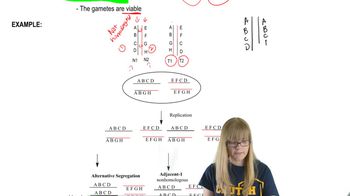Here are the essential concepts you must grasp in order to answer the question correctly.
Chromosome Structure
Chromosomes are structures within cells that contain DNA and proteins. They are essential for the proper segregation of genetic material during cell division. Changes in chromosome structure, such as translocations, can disrupt gene function and lead to phenotypic consequences, affecting traits and characteristics of an organism.
Recommended video:
Reciprocal Balanced Translocation
A reciprocal balanced translocation occurs when segments from two different chromosomes are exchanged without any loss of genetic material. While the overall amount of genetic material remains the same, this rearrangement can disrupt gene regulation and lead to abnormal gene expression, potentially resulting in phenotypic changes.
Recommended video:
Phenotypic Consequences
Phenotypic consequences refer to observable traits or characteristics that result from genetic changes. These can include physical attributes, behaviors, or susceptibility to diseases. In the context of chromosome changes, such as translocations, the alteration in gene expression can lead to new phenotypes, which may be beneficial, neutral, or harmful.
Recommended video:
 Verified step by step guidance
Verified step by step guidance Verified video answer for a similar problem:
Verified video answer for a similar problem:



 12:42m
12:42m